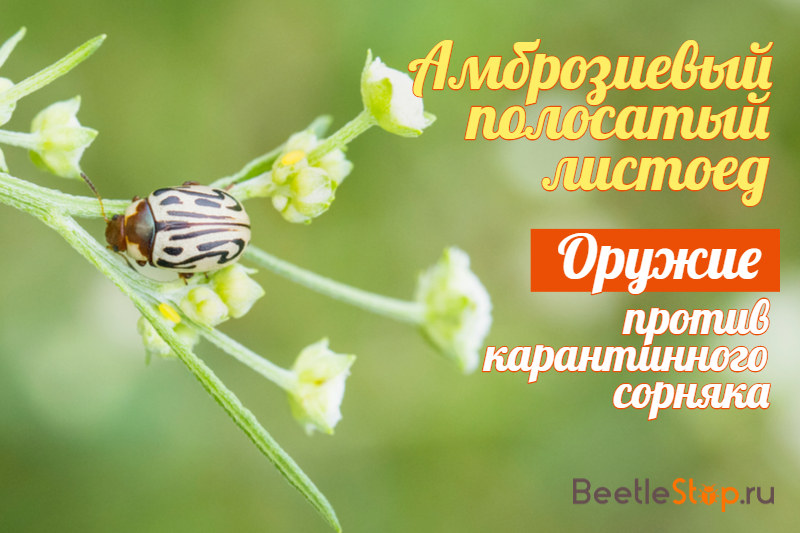Ambrosia striped leaf beetle - the enemy of invasive weeds
Ambrosia is one of the most dangerous quarantine weeds. It deprives the soil of nutrients, makes it difficult to harvest cereals, and clogs pastures. During flowering, the plant causes great harm to human health, causing allergic manifestations. An effective method of weed control is the breeding of entomophages. Striped ragweed beetle - oligophagous beetle. It feeds exclusively on ragweed. The insect was brought from the American continent and successfully acclimatized in Russia.

Morphological description of the species
Striped leaf beetle (Zugogramma suturalis) is a representative of the leaf beetle family, a subfamily of chrysomeline. The popularity of the insect was brought by its feed attachment to a harmful weed. The body of the beetle is oval, convex. The length of the imago is 6-10 mm. Antennae distinct, 11-segmented, eyes large oval. Pronotum transverse with high median tubercle. The head and pronotum are dark brown. Elytra bright with wide longitudinal brown stripes. The covers are shiny with longitudinal rows of large points and grooves. The limbs and antennae are red-brown.
Distribution area
The species Zugogramma suturalis is widespread in the USA and Canada. To combat ragweed, he was introduced to Europe, Asia and Australia. Now insects live in Russia, the CIS countries and China.
Leaf beetles - a biological weapon against ragweed
In the homeland of the striped leaf beetle, 41 species of ragweed grow. From the American continent, weed came to Europe, Africa, and some Asian countries. The most common species is ragweed ragweed. At the end of July, when the plant begins to bloom, the number of rhinitis, asthma attacks and other allergic manifestations sharply increases. Among the measures to destroy the quarantine weed, a biological agent is used - striped ragweed leaf beetle.
Interesting fact. Under the new conditions, the ragweed leaf beetle acquired the ability to fly. In the United States, beetles had weak musculature of the wings. The organ atrophied due to the lack of the need to move around in search of food. After 5 generations, the structure of the wings was restored in the introduced insects. This contributed to its rapid spread in habitats. European and Asian beetles are described as a separate subspecies.
The beetle was brought to Russia in 1978. In the fields of the Stavropol Territory, 1,500 individuals were released. After 5 years, insects completely destroyed the weeds in the experimental plot and began to settle in the surrounding fields. Each number of beetles increased by 30 times. It reached a density of 5,000 adults per square meter. m. 10 years after the start of the experiment conducted research in the nearest fields. It turned out that in areas with crop rotation, the phytophage did not affect the number of fodder plants.
Lifestyle & Reproduction
Striped leaf beetles hibernate at the adult stage. In the spring, they leave the soil for food. The mass appearance of insects occurs at the end of April. During this period, ragweed sprouts no more than 5 cm. One beetle eats 6 weeds in 10 days. Most females go to the winter fertilized, so they do not need to wait for the appearance of partners.Such females, after additional feeding, proceed to oviposition.
Mating beetles occurs in the morning or evening hours, copulation lasts from several minutes to an hour. Over the next 22-40 days, the female lays 2-3 eggs at the tip of the ragweed leaf. The total fertility of the female is 400-550 eggs. Embryos develop 12-14 days. Larvae of the first age prefer to feed on the tops of the weed. Offspring of older ages creep into different parts of the plant. The development of larvae takes about 1 month. Beetles pupate in the soil. The pupal stage lasts up to 15 days. Adults appear in June-July. Young insects actively reduce the amount of flowering weed.
Information. In America, beetles give two generations per year, in China at a temperature of + 26 ° the number of generations increases to three. In the Stavropol Territory leaf beetles give one generation.
The beetroot ragweed was well acclimatized in Russia, but it turned out that the beetle is able to destroy weed only in places of constant growth. In agrocenoses with crop rotation, this effect is not observed. Beetles do not have time to create a high population density, which is necessary for a noticeable effect on the number of fodder plants. From Yugoslavia and China, where insects were also brought in to control weeds, there is no news of the successful destruction of ragweed.

